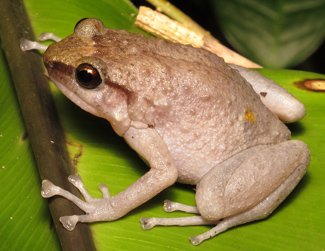New boulder frogs discovered in Queensland

TWO NEW FROG SPECIES have been discovered in remote areas of the Cape York Peninsula in Queensland.
Biologists found the frogs among large stacks of boulders, where the amphibians spend their whole lives. The find doubles the number of known boulder-dwelling frogs in Australia.
The golden-capped boulder frog (Cophixalus pakayakulangun) and kutini boulder frog (Cophixalus kulakula) are about 5cm long – giants compared to their 2cm relatives living in the rainforest.
“We both knew straight away they were new species. We could just tell from their size and shape and colour pattern,” says Dr Conrad Hoskin, a biologist from James Cook University in Townsville.
Together with Kieran Aland from the Queensland Museum, Conrad flew into the remote region during last year’s wet season, hiking through dense rainforest near the Lockhart River in Cape York to search for frogs and lizards.
Frogs in the rocks
The new species are remarkably adapted to their rocky lifestyle, Conrad told Australian Geographic. “They don’t have big back legs like typical frogs,” he says. “They’ve got long arms and big hands with huge triangular finger pads to help them move through the boulders. They don’t so much hop as climb around – a bit like a gecko.”
During the harsh dry season, the frogs retreat into deep chambers between the rocks to escape the heat. “Deep down in those rocks it’s quite cool and moist,” says Conrad. “I think they’re conserving water down there, just tucked away waiting for the rains.”
Few other species inhabit the boulder stacks, he says. But the golden-capped and kutini boulder frogs emerge in abundance during the wet season, picking off ants, beetles and cockroaches. “If you wait till dark, you see them all coming out of the rocks,” he says. “It’s really amazing.”

The golden-boulder frog (Cophixalus pakayakulangun),
a new species. (Credit: Kieran Aland)
A new frog species found every year
The two species – whose names are derived from the local indigenous Kuuku Ya-u language – have eluded scientists for so long because heavy rains make the area almost inaccessible. “One of the reasons they’ve never been found before is that no one’s gone and looked in the wet season in the right spot,” says Conrad. “It’s so inaccessible up there – the roads become impassable.”
Professor Dale Roberts, an expert on frogs from the University of Western Australia, says it can be particularly difficult to find microhylid frogs – the family to which the boulder frogs belong.
“A lot of these microhylids have very, very small distributions – so they’re easy to overlook in surveys,” says Dale. “And some of the areas in far north Queensland are just a nightmare to access.”
On average, one to two frog species are discovered in Australia each year, says Dale, so new findings are always exciting.
Conrad and Kieran are planning further expeditions to far north Queensland, and they suspect other frog and reptile species await discovery. “We’re both going to keep exploring various areas of Cape York,” says Conrad. “We’ll be looking for more frogs and lizards and things like that.”
Their findings were published last month in the journal Zootaxa.
RELATED STORIES

